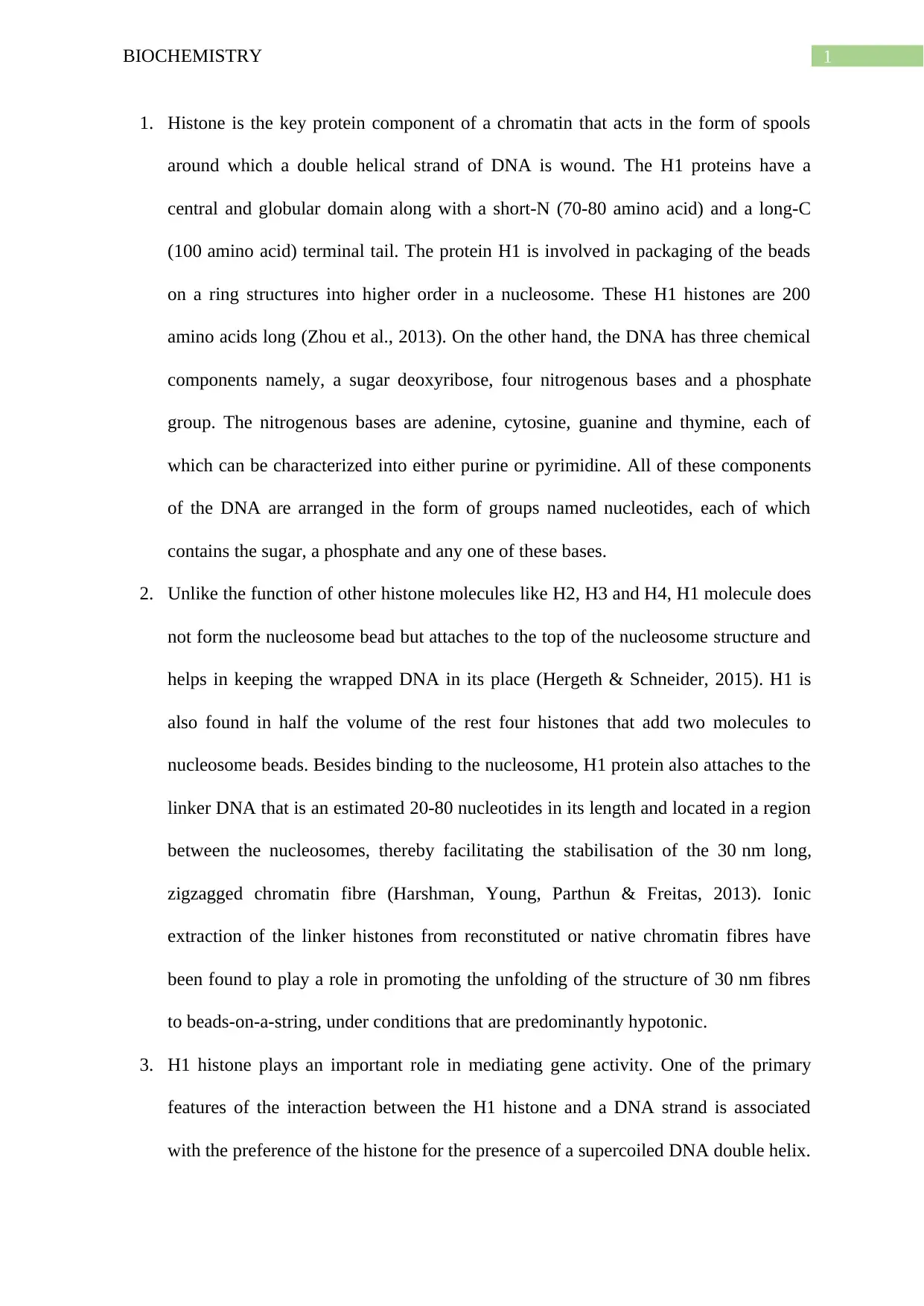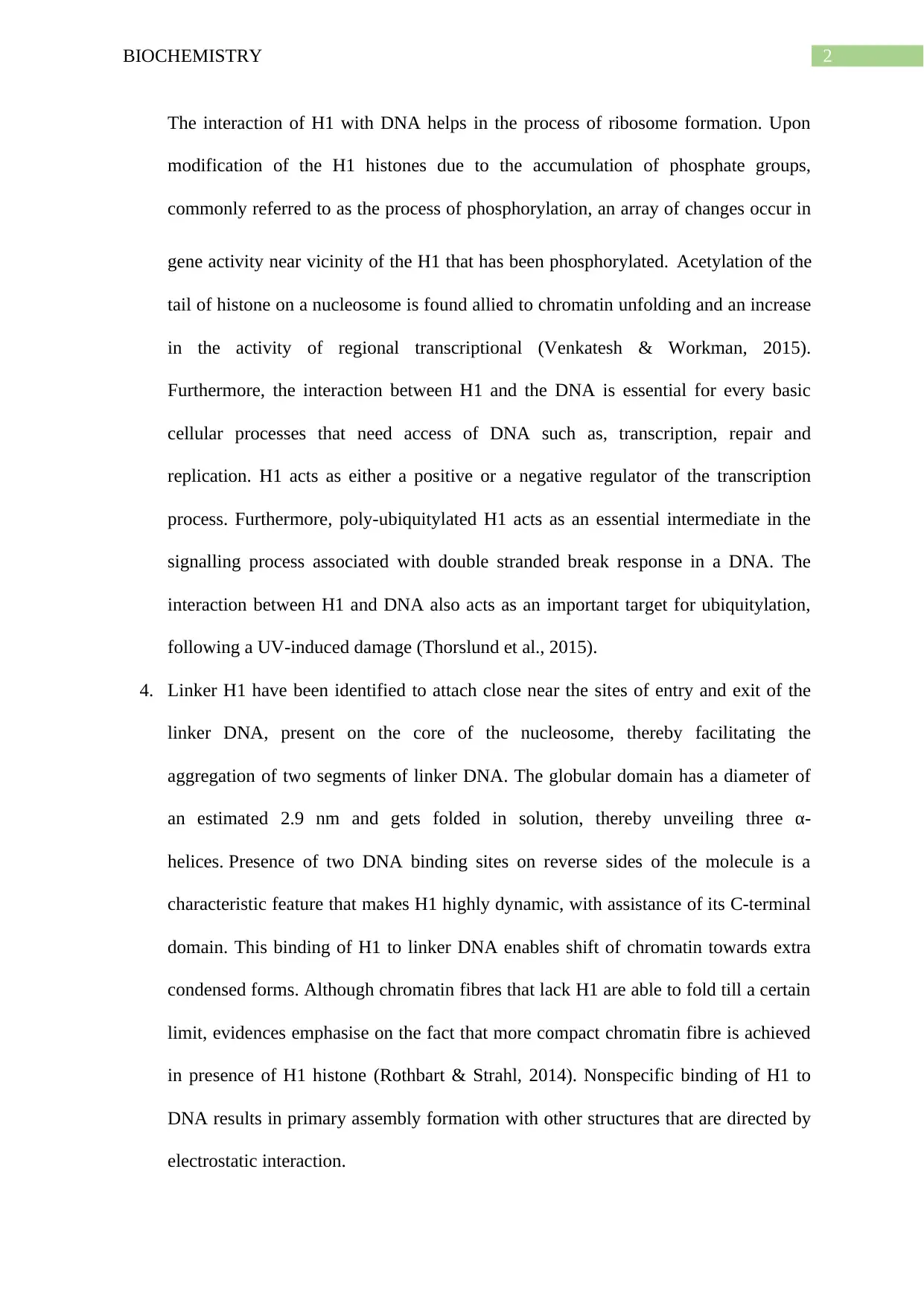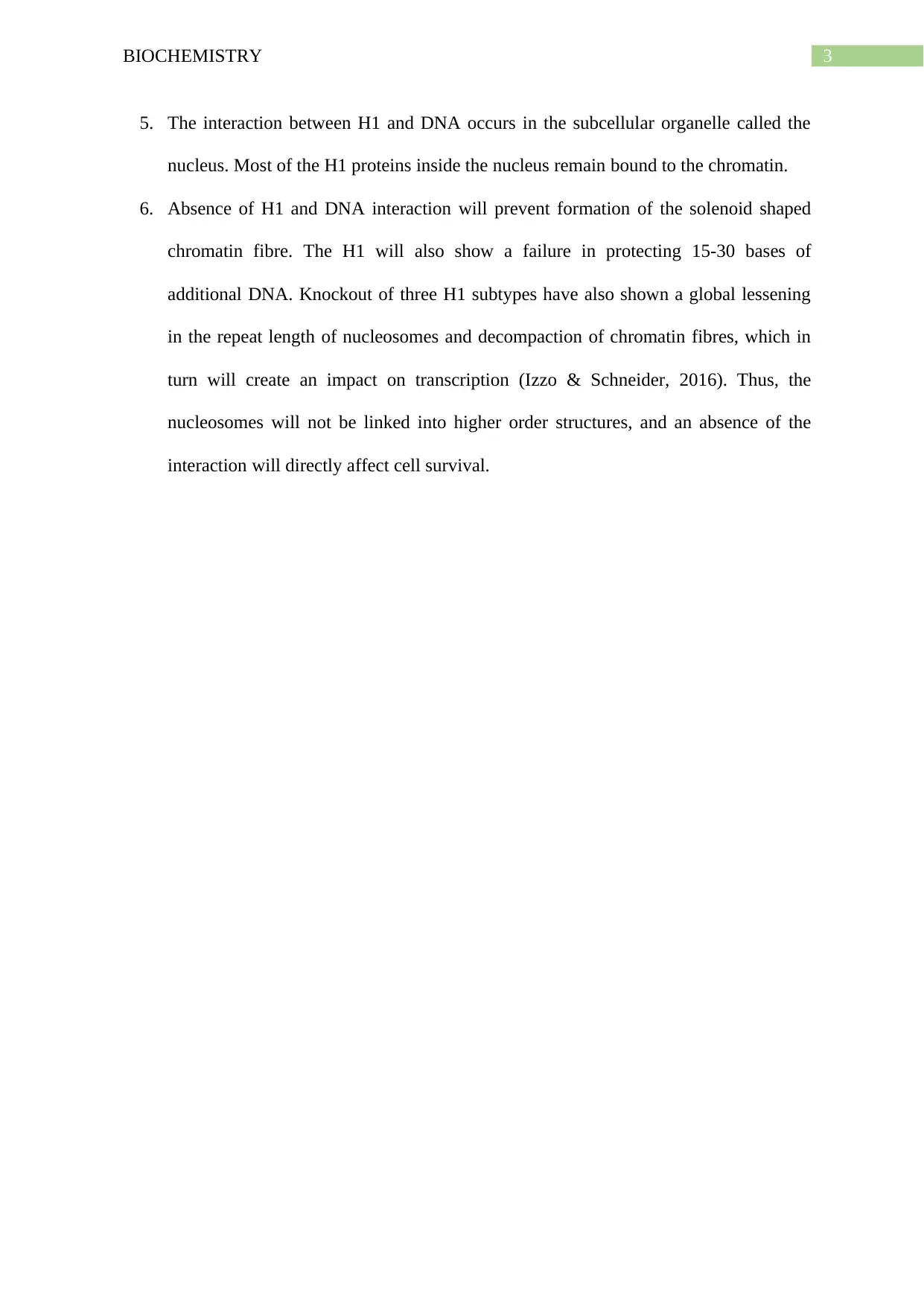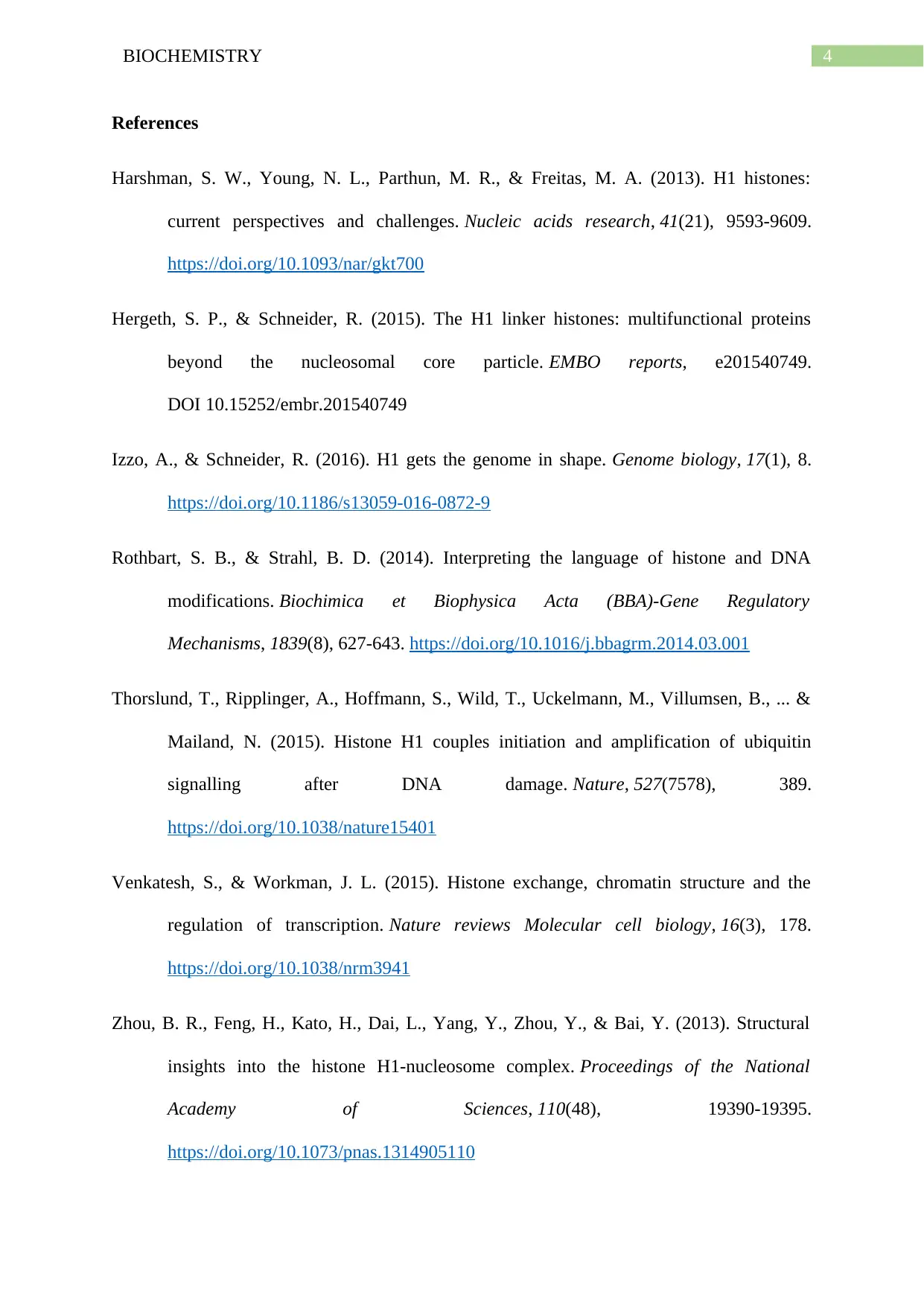Biochemistry: An In-depth Report on Histone 1-DNA Interaction
VerifiedAdded on 2023/06/09
|6
|1211
|75
Report
AI Summary
This report delves into the intricate interaction between Histone 1 (H1) and DNA, highlighting H1's role as a key protein component in chromatin structure. Unlike other histone molecules, H1 does not form the nucleosome bead but attaches to it, stabilizing the wrapped DNA and facilitating the formation of higher-order chromatin structures. The report emphasizes the importance of H1 in gene activity, particularly its preference for supercoiled DNA and its involvement in processes like ribosome formation, transcription, repair, and replication. Post-translational modifications of H1, such as phosphorylation and acetylation, are discussed in the context of gene regulation. The report also addresses the structural aspects of H1, including its globular domain and DNA-binding sites, and the consequences of H1 absence on chromatin fiber formation and cell survival. The interaction between H1 and DNA occurs within the nucleus, and maintaining this interaction is crucial for proper cellular function.

Running head: BIOCHEMISTRY
Histone 1- DNA interaction
Name of the Student
Name of the University
Author Note
Histone 1- DNA interaction
Name of the Student
Name of the University
Author Note
Paraphrase This Document
Need a fresh take? Get an instant paraphrase of this document with our AI Paraphraser

1BIOCHEMISTRY
1. Histone is the key protein component of a chromatin that acts in the form of spools
around which a double helical strand of DNA is wound. The H1 proteins have a
central and globular domain along with a short-N (70-80 amino acid) and a long-C
(100 amino acid) terminal tail. The protein H1 is involved in packaging of the beads
on a ring structures into higher order in a nucleosome. These H1 histones are 200
amino acids long (Zhou et al., 2013). On the other hand, the DNA has three chemical
components namely, a sugar deoxyribose, four nitrogenous bases and a phosphate
group. The nitrogenous bases are adenine, cytosine, guanine and thymine, each of
which can be characterized into either purine or pyrimidine. All of these components
of the DNA are arranged in the form of groups named nucleotides, each of which
contains the sugar, a phosphate and any one of these bases.
2. Unlike the function of other histone molecules like H2, H3 and H4, H1 molecule does
not form the nucleosome bead but attaches to the top of the nucleosome structure and
helps in keeping the wrapped DNA in its place (Hergeth & Schneider, 2015). H1 is
also found in half the volume of the rest four histones that add two molecules to
nucleosome beads. Besides binding to the nucleosome, H1 protein also attaches to the
linker DNA that is an estimated 20-80 nucleotides in its length and located in a region
between the nucleosomes, thereby facilitating the stabilisation of the 30 nm long,
zigzagged chromatin fibre (Harshman, Young, Parthun & Freitas, 2013). Ionic
extraction of the linker histones from reconstituted or native chromatin fibres have
been found to play a role in promoting the unfolding of the structure of 30 nm fibres
to beads-on-a-string, under conditions that are predominantly hypotonic.
3. H1 histone plays an important role in mediating gene activity. One of the primary
features of the interaction between the H1 histone and a DNA strand is associated
with the preference of the histone for the presence of a supercoiled DNA double helix.
1. Histone is the key protein component of a chromatin that acts in the form of spools
around which a double helical strand of DNA is wound. The H1 proteins have a
central and globular domain along with a short-N (70-80 amino acid) and a long-C
(100 amino acid) terminal tail. The protein H1 is involved in packaging of the beads
on a ring structures into higher order in a nucleosome. These H1 histones are 200
amino acids long (Zhou et al., 2013). On the other hand, the DNA has three chemical
components namely, a sugar deoxyribose, four nitrogenous bases and a phosphate
group. The nitrogenous bases are adenine, cytosine, guanine and thymine, each of
which can be characterized into either purine or pyrimidine. All of these components
of the DNA are arranged in the form of groups named nucleotides, each of which
contains the sugar, a phosphate and any one of these bases.
2. Unlike the function of other histone molecules like H2, H3 and H4, H1 molecule does
not form the nucleosome bead but attaches to the top of the nucleosome structure and
helps in keeping the wrapped DNA in its place (Hergeth & Schneider, 2015). H1 is
also found in half the volume of the rest four histones that add two molecules to
nucleosome beads. Besides binding to the nucleosome, H1 protein also attaches to the
linker DNA that is an estimated 20-80 nucleotides in its length and located in a region
between the nucleosomes, thereby facilitating the stabilisation of the 30 nm long,
zigzagged chromatin fibre (Harshman, Young, Parthun & Freitas, 2013). Ionic
extraction of the linker histones from reconstituted or native chromatin fibres have
been found to play a role in promoting the unfolding of the structure of 30 nm fibres
to beads-on-a-string, under conditions that are predominantly hypotonic.
3. H1 histone plays an important role in mediating gene activity. One of the primary
features of the interaction between the H1 histone and a DNA strand is associated
with the preference of the histone for the presence of a supercoiled DNA double helix.

2BIOCHEMISTRY
The interaction of H1 with DNA helps in the process of ribosome formation. Upon
modification of the H1 histones due to the accumulation of phosphate groups,
commonly referred to as the process of phosphorylation, an array of changes occur in
gene activity near vicinity of the H1 that has been phosphorylated. Acetylation of the
tail of histone on a nucleosome is found allied to chromatin unfolding and an increase
in the activity of regional transcriptional (Venkatesh & Workman, 2015).
Furthermore, the interaction between H1 and the DNA is essential for every basic
cellular processes that need access of DNA such as, transcription, repair and
replication. H1 acts as either a positive or a negative regulator of the transcription
process. Furthermore, poly-ubiquitylated H1 acts as an essential intermediate in the
signalling process associated with double stranded break response in a DNA. The
interaction between H1 and DNA also acts as an important target for ubiquitylation,
following a UV-induced damage (Thorslund et al., 2015).
4. Linker H1 have been identified to attach close near the sites of entry and exit of the
linker DNA, present on the core of the nucleosome, thereby facilitating the
aggregation of two segments of linker DNA. The globular domain has a diameter of
an estimated 2.9 nm and gets folded in solution, thereby unveiling three α-
helices. Presence of two DNA binding sites on reverse sides of the molecule is a
characteristic feature that makes H1 highly dynamic, with assistance of its C-terminal
domain. This binding of H1 to linker DNA enables shift of chromatin towards extra
condensed forms. Although chromatin fibres that lack H1 are able to fold till a certain
limit, evidences emphasise on the fact that more compact chromatin fibre is achieved
in presence of H1 histone (Rothbart & Strahl, 2014). Nonspecific binding of H1 to
DNA results in primary assembly formation with other structures that are directed by
electrostatic interaction.
The interaction of H1 with DNA helps in the process of ribosome formation. Upon
modification of the H1 histones due to the accumulation of phosphate groups,
commonly referred to as the process of phosphorylation, an array of changes occur in
gene activity near vicinity of the H1 that has been phosphorylated. Acetylation of the
tail of histone on a nucleosome is found allied to chromatin unfolding and an increase
in the activity of regional transcriptional (Venkatesh & Workman, 2015).
Furthermore, the interaction between H1 and the DNA is essential for every basic
cellular processes that need access of DNA such as, transcription, repair and
replication. H1 acts as either a positive or a negative regulator of the transcription
process. Furthermore, poly-ubiquitylated H1 acts as an essential intermediate in the
signalling process associated with double stranded break response in a DNA. The
interaction between H1 and DNA also acts as an important target for ubiquitylation,
following a UV-induced damage (Thorslund et al., 2015).
4. Linker H1 have been identified to attach close near the sites of entry and exit of the
linker DNA, present on the core of the nucleosome, thereby facilitating the
aggregation of two segments of linker DNA. The globular domain has a diameter of
an estimated 2.9 nm and gets folded in solution, thereby unveiling three α-
helices. Presence of two DNA binding sites on reverse sides of the molecule is a
characteristic feature that makes H1 highly dynamic, with assistance of its C-terminal
domain. This binding of H1 to linker DNA enables shift of chromatin towards extra
condensed forms. Although chromatin fibres that lack H1 are able to fold till a certain
limit, evidences emphasise on the fact that more compact chromatin fibre is achieved
in presence of H1 histone (Rothbart & Strahl, 2014). Nonspecific binding of H1 to
DNA results in primary assembly formation with other structures that are directed by
electrostatic interaction.
⊘ This is a preview!⊘
Do you want full access?
Subscribe today to unlock all pages.

Trusted by 1+ million students worldwide

3BIOCHEMISTRY
5. The interaction between H1 and DNA occurs in the subcellular organelle called the
nucleus. Most of the H1 proteins inside the nucleus remain bound to the chromatin.
6. Absence of H1 and DNA interaction will prevent formation of the solenoid shaped
chromatin fibre. The H1 will also show a failure in protecting 15-30 bases of
additional DNA. Knockout of three H1 subtypes have also shown a global lessening
in the repeat length of nucleosomes and decompaction of chromatin fibres, which in
turn will create an impact on transcription (Izzo & Schneider, 2016). Thus, the
nucleosomes will not be linked into higher order structures, and an absence of the
interaction will directly affect cell survival.
5. The interaction between H1 and DNA occurs in the subcellular organelle called the
nucleus. Most of the H1 proteins inside the nucleus remain bound to the chromatin.
6. Absence of H1 and DNA interaction will prevent formation of the solenoid shaped
chromatin fibre. The H1 will also show a failure in protecting 15-30 bases of
additional DNA. Knockout of three H1 subtypes have also shown a global lessening
in the repeat length of nucleosomes and decompaction of chromatin fibres, which in
turn will create an impact on transcription (Izzo & Schneider, 2016). Thus, the
nucleosomes will not be linked into higher order structures, and an absence of the
interaction will directly affect cell survival.
Paraphrase This Document
Need a fresh take? Get an instant paraphrase of this document with our AI Paraphraser

4BIOCHEMISTRY
References
Harshman, S. W., Young, N. L., Parthun, M. R., & Freitas, M. A. (2013). H1 histones:
current perspectives and challenges. Nucleic acids research, 41(21), 9593-9609.
https://doi.org/10.1093/nar/gkt700
Hergeth, S. P., & Schneider, R. (2015). The H1 linker histones: multifunctional proteins
beyond the nucleosomal core particle. EMBO reports, e201540749.
DOI 10.15252/embr.201540749
Izzo, A., & Schneider, R. (2016). H1 gets the genome in shape. Genome biology, 17(1), 8.
https://doi.org/10.1186/s13059-016-0872-9
Rothbart, S. B., & Strahl, B. D. (2014). Interpreting the language of histone and DNA
modifications. Biochimica et Biophysica Acta (BBA)-Gene Regulatory
Mechanisms, 1839(8), 627-643. https://doi.org/10.1016/j.bbagrm.2014.03.001
Thorslund, T., Ripplinger, A., Hoffmann, S., Wild, T., Uckelmann, M., Villumsen, B., ... &
Mailand, N. (2015). Histone H1 couples initiation and amplification of ubiquitin
signalling after DNA damage. Nature, 527(7578), 389.
https://doi.org/10.1038/nature15401
Venkatesh, S., & Workman, J. L. (2015). Histone exchange, chromatin structure and the
regulation of transcription. Nature reviews Molecular cell biology, 16(3), 178.
https://doi.org/10.1038/nrm3941
Zhou, B. R., Feng, H., Kato, H., Dai, L., Yang, Y., Zhou, Y., & Bai, Y. (2013). Structural
insights into the histone H1-nucleosome complex. Proceedings of the National
Academy of Sciences, 110(48), 19390-19395.
https://doi.org/10.1073/pnas.1314905110
References
Harshman, S. W., Young, N. L., Parthun, M. R., & Freitas, M. A. (2013). H1 histones:
current perspectives and challenges. Nucleic acids research, 41(21), 9593-9609.
https://doi.org/10.1093/nar/gkt700
Hergeth, S. P., & Schneider, R. (2015). The H1 linker histones: multifunctional proteins
beyond the nucleosomal core particle. EMBO reports, e201540749.
DOI 10.15252/embr.201540749
Izzo, A., & Schneider, R. (2016). H1 gets the genome in shape. Genome biology, 17(1), 8.
https://doi.org/10.1186/s13059-016-0872-9
Rothbart, S. B., & Strahl, B. D. (2014). Interpreting the language of histone and DNA
modifications. Biochimica et Biophysica Acta (BBA)-Gene Regulatory
Mechanisms, 1839(8), 627-643. https://doi.org/10.1016/j.bbagrm.2014.03.001
Thorslund, T., Ripplinger, A., Hoffmann, S., Wild, T., Uckelmann, M., Villumsen, B., ... &
Mailand, N. (2015). Histone H1 couples initiation and amplification of ubiquitin
signalling after DNA damage. Nature, 527(7578), 389.
https://doi.org/10.1038/nature15401
Venkatesh, S., & Workman, J. L. (2015). Histone exchange, chromatin structure and the
regulation of transcription. Nature reviews Molecular cell biology, 16(3), 178.
https://doi.org/10.1038/nrm3941
Zhou, B. R., Feng, H., Kato, H., Dai, L., Yang, Y., Zhou, Y., & Bai, Y. (2013). Structural
insights into the histone H1-nucleosome complex. Proceedings of the National
Academy of Sciences, 110(48), 19390-19395.
https://doi.org/10.1073/pnas.1314905110

5BIOCHEMISTRY
⊘ This is a preview!⊘
Do you want full access?
Subscribe today to unlock all pages.

Trusted by 1+ million students worldwide
1 out of 6
Related Documents
Your All-in-One AI-Powered Toolkit for Academic Success.
+13062052269
info@desklib.com
Available 24*7 on WhatsApp / Email
![[object Object]](/_next/static/media/star-bottom.7253800d.svg)
Unlock your academic potential
Copyright © 2020–2025 A2Z Services. All Rights Reserved. Developed and managed by ZUCOL.





